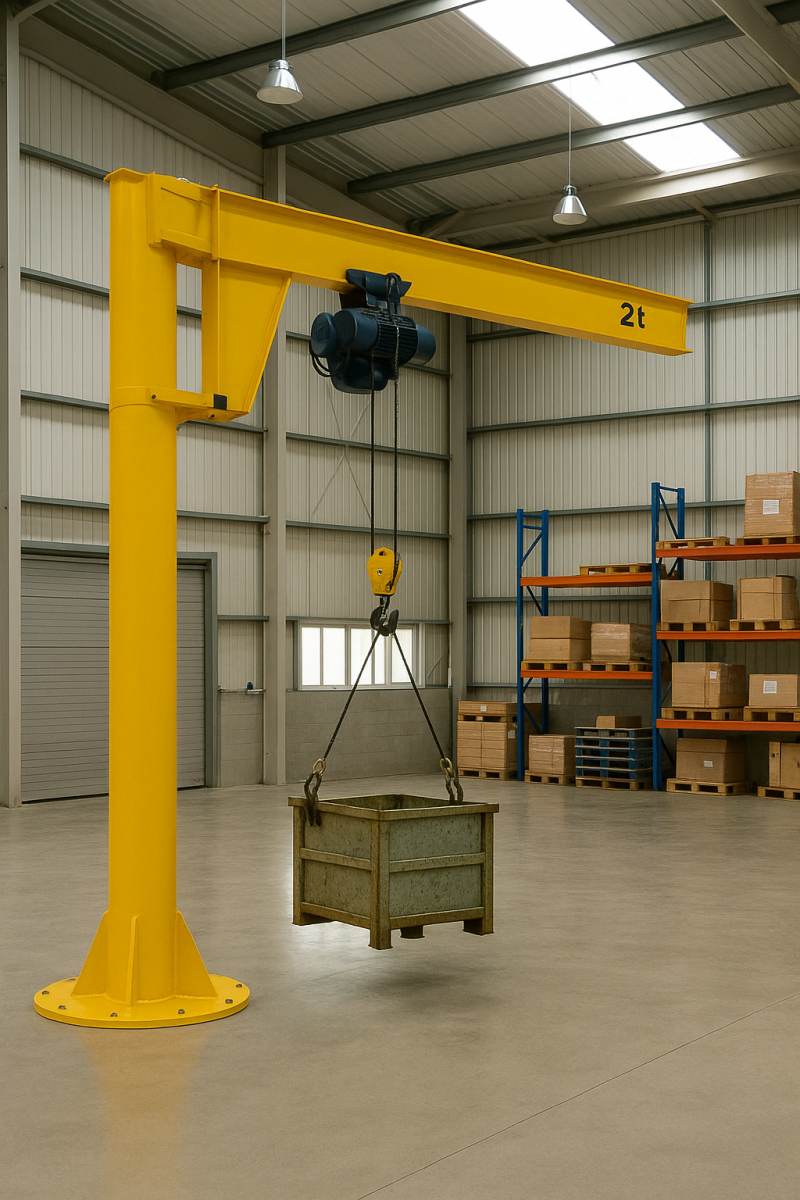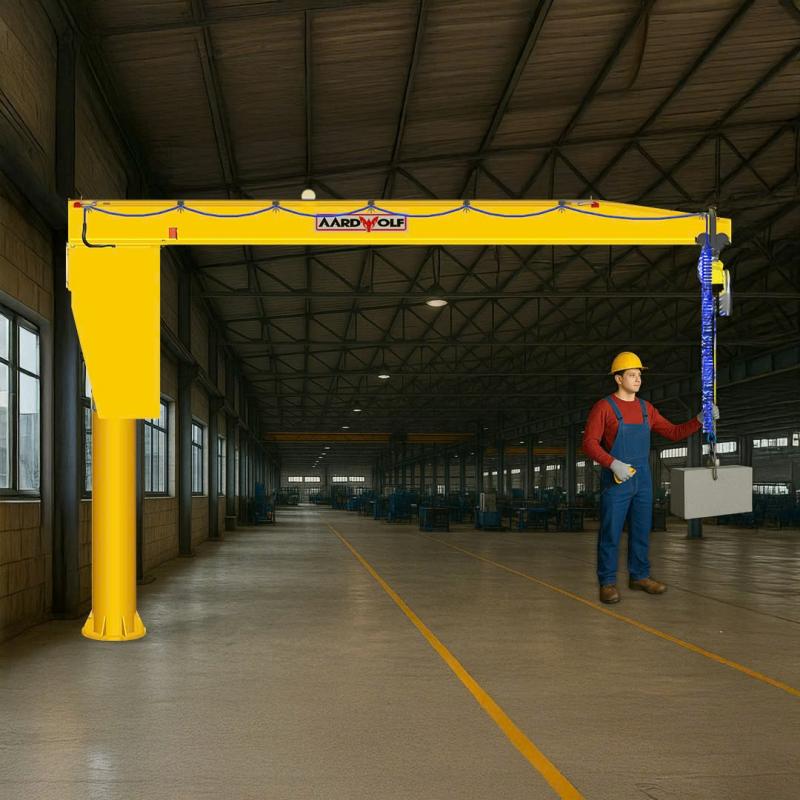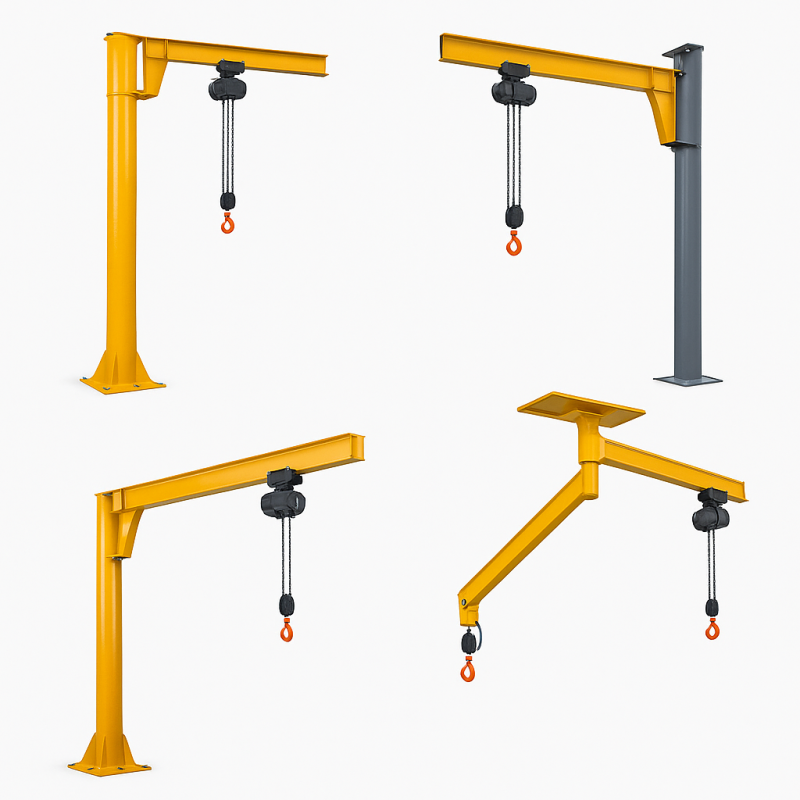



From metal fabrication shops and warehouses to production lines and construction yards, one tool consistently delivers exceptional results: jib cranes.
Jib cranes are compact, powerful lifting systems designed to handle localized loads with speed, precision, and control. With variations such as freestanding jib cranes, wall mounted jib cranes, ceiling mounted jib cranes, articulating jib cranes, and pillar jib cranes, these machines provide tailored solutions for diverse industrial needs.
This article explores why jib cranes are a cornerstone of modern material handling and how different types meet specific operational demands.

Lifting, moving, and positioning materials in confined or repetitive workflows presents logistical and safety challenges. Jib cranes are purpose-built to address these challenges.
To explore upcoming trends in crane innovation, see Trends of Jib Cranes Installation.
At their core, jib cranes consist of a horizontal arm (the “jib” or “boom”), a hoist mounted on a trolley, and a pivot mechanism that allows for radial rotation.
These functions make jib cranes ideal for repetitive lifting within defined zones—like loading docks, workbenches, or fabrication cells.
To see how jib cranes compare with other lifting systems, read Jib Cranes.
Not all jib cranes are created equal. Each model has its own mounting method, swing radius, and load capacity. Selecting the right type is crucial for optimizing performance.
Mounted on a reinforced concrete foundation, freestanding jib cranes offer full 360° rotation and high load capacities.
Use Cases:
Efficiency Benefits:
Learn more about The core types of Jib Cranes.
Affixed to a structural wall or building column, wall mounted jib cranes provide up to 200° of swing.
Use Cases:
Efficiency Benefits:
Explore practical models such as A Wall-mounted Jib Crane.
Suspended from overhead beams or trusses, ceiling mounted jib cranes are ideal for areas with limited floor space.
Use Cases:
Efficiency Benefits:
Equipped with dual rotating arms, articulating jib cranes offer unmatched flexibility in navigating around machinery or other obstacles.
Use Cases:
Efficiency Benefits:
See popular articulating models at How many core types of Jib Cranes.
Also known as column-mounted cranes, pillar jib cranes are bolted to the floor using a baseplate. They offer partial to full rotation and are often used in smaller shops or maintenance bays.
Use Cases:
Efficiency Benefits:
From loading dock to production floor, jib cranes enhance performance at multiple levels:
Jib cranes allow for rapid lifting and repositioning, reducing delays and increasing cycle speeds.
Operators can move heavy materials without physical strain, lowering the risk of injury and improving task efficiency.
Wall and ceiling-mounted variants free up floor space for other equipment or safe movement of personnel.
Compared to forklifts or large overhead systems, jib cranes require less maintenance, lower energy usage, and minimal floor disruption.
| Industry | Recommended Crane Type | Reason |
|---|---|---|
| Steel Fabrication | Freestanding or Pillar | Heavy lifting near machines |
| Electronics Assembly | Articulating or Wall Mounted | Precise, safe positioning in compact zones |
| Warehousing | Freestanding or Ceiling | Wide-area coverage and efficient pallet handling |
| Automotive Repair | Pillar or Articulating | Repetitive lifting in service bays |
| Food & Beverage | Ceiling Mounted | Clean, unobstructed floor space with minimal contamination |
Read about practical deployment in Cases for different Jib Crane Types.

Consider these factors when selecting a jib crane for your operation:
Jib cranes are more than just simple lifting tools—they’re strategic assets for optimizing space, enhancing safety, and driving productivity across industrial settings. From the high capacity of a freestanding jib crane to the ergonomic precision of an articulating jib crane, there’s a solution for every environment.
Understanding the core types and their advantages allows operations managers, engineers, and facility planners to make smarter, more cost-effective decisions.
Start exploring your options today with The core types of Jib Cranes or browse A Wall-mounted Jib Crane to see how these efficient systems can transform your workflow.
1. How to operate a Jib Cranes safely
3. Over brace jib crane wall mounted
5. Is a Jib Crane a Gantry Crane
6. Articulated Jib Crane Wall Mounted
8. Manual Counterbalance Crane
10. Over Braced Jib Crane Column Mounted
Sign up to receive the latest info on new Aardwolf products, special offers and more.
By signing up you agree to receive emails from Aardwolf with news, special offers, promotions and other information. You can unsubscribe at any time.